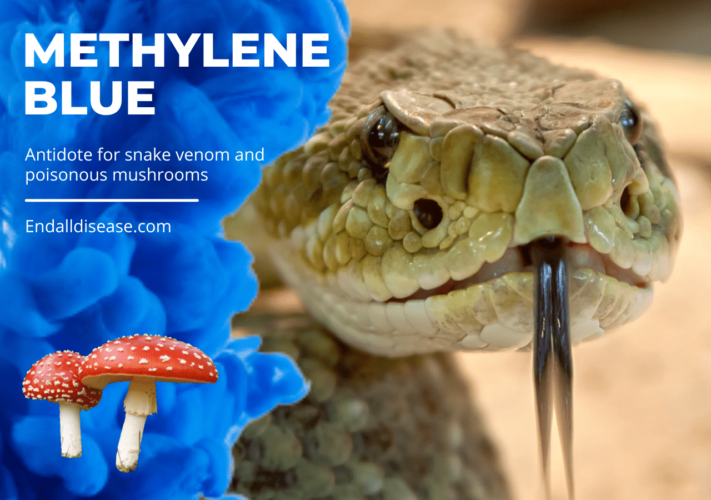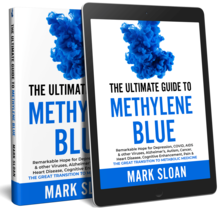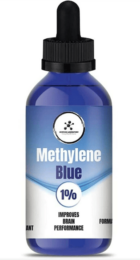Methylene Blue: Miracle Antidote for Poisonings and Overdoses

Got bit by a rattlesnake or eat a poisonous mushroom and looking for an antidote? Look no further than the wonder-drug methylene blue – a medicinal blue dye that acts as an antidote for chemical poisoning and overdose.
It’s inexpensive, easily obtainable, remarkably safe, and it’s the first line of defense in most hospital emergency rooms across the world used on people admitted for overdose and chemical poisonings of all types.[R]
If you’ve never heard of methylene blue, you aren’t paying attention! This drug is so essential and routinely used in hospital emergency rooms for conditions like circulatory shock, neuroprotection, severe allergic reactions, overdoses and chemical poisonings, that US, Japanese, Greek and Italian scientists have recommended that hospitals stockpile it.[R]
In this article, you’ll learn how and why methylene blue can be used as an antidote for all types of chemical poisonings or drug overdoses. Also included is the exact dose used by hospital as an antidote to chemical poisoning.
TABLE OF CONTENTS
Methylene Blue History as an Antidote
The story of methylene blue as an antidote for poisonings and drug overdoses began around 1930, after Dr Matilda Brooks suggested using it as an antidote for cyanide and carbon monoxide poisoning. This recommendation came after a number of animal studies she conducted using methylene blue against the toxicity of cyanide and carbon monoxide.[R]
Since then, cyanide victims in emergency rooms worldwide have been successfully treated with methylene blue administered intravenously. But methylene blue works as an antidote for far more than just cyanide and carbon monoxide poisoning.
It’s important to understand that all chemical poisonings induce a situation in the body called methemoglobinemia, which is a condition methylene blue has been FDA approved to treat. Once you understand this condition physiologically and how methylene blue can correct the root cause of the problem, you’ll understand its value as an antidote for virtually all chemical poisonings.
Methylene Blue for Methemoglobinemia
Methemoglobinemia is a blood disorder occurring when hemoglobin inside red blood cells becomes oxidized and loses its ability to transport oxygen. Oxidized hemoglobin is called methemoglobin and its presence in the blood leads to tissue hypoxia. In the absence of oxygen, nitric oxide and a cascade of stress hormones and pro-inflammatory signals are elevated, and energy production by cells is stifled.
Symptoms of Methemoglobinemia
Common symptoms of methemoglobinemia include:
- Blue fingertips (cyanosis)
- Shortness of breath (dyspnea)
- Confusion
- Seizures
- Coma
- Metabolic acidosis
- Chocolate brown-colored blood
Causes of Methemoglobinemia
- Cyanide
- Carbon monoxide
- Sodium nitrite/nitrate
- Acetaminophen
- Formaldehyde
- Pharmaceutical drugs
- Snake Venom
- Mushroom Poisoning
- The party drug ‘poppers’ (amyl nitrate)
- Lidocaine, benzocaine and other anesthetics
- Heavy metals like aluminum, copper, cadmium, etc.
- Fluoride, found in toothpaste
- Chemicals found in household cleaning products
- Chemicals found in drugstore shampoos, deodorants and soaps
- COVID-19 also induces methemoglobinemia
Methylene Blue Treatment for Methemoglobinemia
When doctors administer methylene blue intravenously to methemoglobinemia patients, the medicine acts as an antidote by converting methemoglobin back to hemoglobin, which restores its oxygen-carrying capacity. Once oxygen use is restored, all the symptoms experienced by the patient are then eliminated and health is restored.
Most doctors and nurses administering methylene blue for chemical poisonings and overdoses are not aware that methylene blue’s value as an antidote extends far beyond its capacity to convert oxidized hemoglobin back to its regular form.
A 2018 study examining the use of methylene blue for cyanide poisoning wrote: “Its protective effects appear to be related to the unique properties of this redox dye, which, depending on the dose, could directly oppose some of the consequences of the metabolic depression produced by CN [cyanide] at the cellular level.”
Said differently, methylene blue works by correcting the defective cellular metabolism caused by the poison.[R]
Dose
What dose of methylene blue is effective for treating methemoglobinemia/poisoning/overdose?
In hospitals, methemoglobinemia victims are administered a methylene blue dose of 2mg/kg intravenously over the course of 5 minutes.
Somebody choosing to treat themselves orally in a glass of juice or water could use the same dose also. The following dose chart can help you determine the dose you’ll need for your bodyweight.
| Methylene Blue Doses (1% Solution) | |||
| Bodyweight | 0.5 mg/kg | 1 mg/kg | 2 mg/kg |
| 50kg/110lbs | 25mg dose (50 drops/day) | 50mg dose (100 drops/day) | 100mg dose (200 drops/day) |
| 55kg/121lbs | 27.5mg dose (55 drops/day) | 55mg dose (110 drops/day) | 110mg dose (220 drops/day) |
| 60kg/132lbs | 30mg dose (60 drops/day) | 60mg dose (120 drops/day) | 120mg dose (240 drops/day) |
| 65kg/143lbs | 32.5mg dose (65 drops/day) | 65mg dose (130 drops/day) | 130mg dose (260 drops/day) |
| 70kg/154lbs | 35mg dose (70 drops/day) | 70mg dose (140 drops/day) | 140mg dose (280 drops/day) |
| 75kg/165lbs | 37.5mg dose (75 drops/day) | 75mg dose (150 drops/day) | 150mg dose (300 drops/day) |
| 80kg/176lbs | 40mg dose (80 drops/day) | 80mg dose (160 drops/day) | 160mg dose (320 drops/day) |
| 85kg/187lbs | 42.5mg dose (85 drops/day) | 85mg dose (170 drops/day) | 170mg dose (340 drops/day) |
| 90kg/198lbs | 45mg dose (90 drops/day) | 90mg dose (180 drops/day) | 180mg dose (360 drops/day) |
| 95kg/209lbs | 47.5mg dose (95 drops/day) | 95mg dose (190 drops/day) | 190mg dose (380 drops/day) |
| 100kg/220lbs | 50mg dose (100 drops/day) | 100mg dose (200 drops/day) | 200mg dose (400 drops/day) |

The Ultimate Guide to Methylene Blue
Please note, oral doses of 0.5-2mg/kg mixed in water or juice taste bitter and can stain the teeth for a period of time. To avoid this, consuming it through a straw will reduce both the bitter taste and tooth staining.
Conclusion
Methemoglobinemia is the condition wrought by oxidized hemoglobin seen in poisonings and overdoses of all kinds. Oxidized hemoglobin is unable to carry oxygen, so the ailment causes widespread hypoxia, which can be deadly if not treated quickly. The key to treating it is to restore the hemoglobin back to its original (non-oxidized) state, and methylene blue is one of the safest and most effective ways to make that happen.
If you ever eat a poisonous mushroom or are bit by a rattlesnake and manage to call an ambulance to take you to the hospital, your treatment will most likely be methylene blue (and also activated charcoal and sodium bicarbonate).
For the people who like to be prepared or don’t want to risk having to wait for rescue crews, having a bottle of methylene blue close by at all times on your next hike or camping trip is a wise choice and could save your life.
Thanks for reading!
If you want to learn more about methylene blue, checkout my #1 bestselling book The Ultimate Guide to Methylene Blue at https://www.endalldisease.com/methylenebluebook
References
Caroline FB, Luiza MS, Livia A, et al. Why methylene blue have to be always present in the stocking of emergency antidotes. Current Drug Targets.
Abstract:
Evidence-based review of the existing literature ultimately recommends stocking of Methylene Blue (MB) as an emergency antidote in the United States. The same is reported around the world in Japan, Greece, Italy and Canada. The observation that MB is always present as the main antidote required in emergency and critical care units calls for a revisit on its effects on the NO/cGMP system to reemphasize its multisystem actions. Therefore, the present review aimed to display the role of MB in emergency units, concerning: 1) Polytrauma and circulatory shock; 2) Neuroprotection, 3) Anaphylaxis and, 4) Overdose and poisoning.
https://www.eurekaselect.com/node/160936/article/why-methylene-blue-have-to-be-always-present-in-the-stocking-of-emergency-antidotes
Brooks MM. Methylene blue as antidote for cyanide and carbon monoxide poisoning. Journal of the American Medical Association. 1933;100(1):59-59.
To the Editor: —I have just seen in The Journal, Dec. 3, 1932, page 1944, an article written by Dr. J. C. Geiger in which he mentioned several case histories of cyanide poisoning with and without the use of methylene blue (methylthionine chloride, U. S. P.).The action of methylene blue on cyanide and carbon monoxide has been known a long time in theoretical biology, but I was first to suggest that it be used as an antidote for cyanide and carbon monoxide poison cases, as a result of some studies which I made on animals under a grant from the medical school here, and as a result of extensive reading which I have done.At a meeting of the Society for Experimental Biology and Medicine, which took place last April, Dr. Hanzlik heard my paper on the use of methylene blue as an antidote for cyanide and carbon monoxide
https://jamanetwork.com/journals/jama/article-abstract/241035
Haouzi P, Gueguinou M, Sonobe T, et al. Revisiting the physiological effects of methylene blue as a treatment of cyanide intoxication. Clin Toxicol (Phila). 2018;56(9):828-840.
Abstract
Background: Although methylene blue (MB) had long been proposed to counteract the effects of cyanide (CN) intoxication, research on its mechanisms of action and efficacy has been abandoned for decades. Recent studies on the benefits of MB in post-anoxic injuries have prompted us to reexamine the relevance of this historical observation.
Methods: Our study was performed in adult male Sprague-Dawley rats and on HEK293T epithelial cells. First, the effects and toxicity of MB (0-80 mg/kg) on circulation and metabolism were established in four urethane-anesthetized rats. Then nine rats received a lethal infusion of a solution of KCN (0.75 mg/kg/min) and were treated by either saline or MB, at 20 mg/kg, a dose that we found to be innocuous in rat and to correspond to a dose of about 4 mg/kg in humans. MB was also administered 5 min after the end of a sub-lethal exposure to CN in a separate group of 10 rats. In addition, ATP/ADP ratio, ROS production, mitochondrial membrane potential (Δψm) and cellular O2 consumption rate (OCR) were determined in HEK293T cells exposed to toxic levels of CN (200 µM for 10 min) before and after applying a solution containing MB (1-100 µM for 10 min).
Results: Methylene blue was found to be innocuous up to 50 mg/kg. KCN infusion (0.75 mg/kg/min) killed all animals within 7-8 min. MB (20 mg/kg) administered at the same time restored blood pressure, cardiac contractility and limited O2 deficit, allowing all the animals to survive, without any significant methemoglobinemia. When administered 5 min after a non-lethal CN intoxication, MB sped up the recovery of lactate and O2 deficit. Finally, MB was able to decrease the production of ROS and restore the ATP/ADP ratio, Δψm as well as OCR of epithelial cells intoxicated by CN.
Conclusions: The present observations should make us consider the potential interest of MB in the treatment of CN intoxication. The mechanisms of the antidotal properties of MB cannot be accounted for by the creation of a cyanomethemoglobinemia, rather its protective effects appears to be related to the unique properties of this redox dye, which, depending on the dose, could directly oppose some of the consequences of the metabolic depression produced by CN at the cellular level.
https://pubmed.ncbi.nlm.nih.gov/29451035


